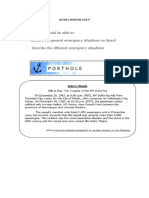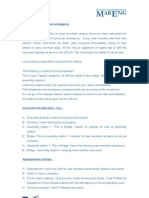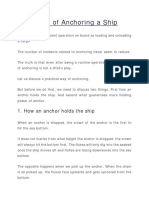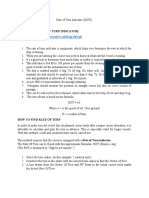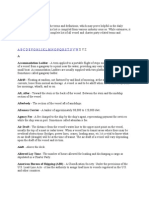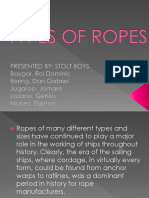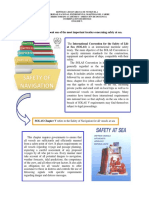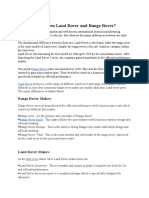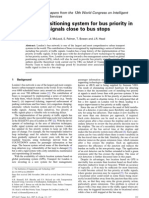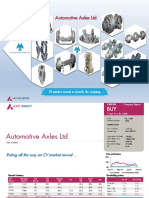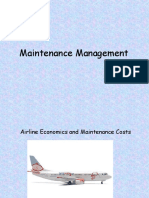SA015 - Loss Prevention Safety Alert - Snap-Back Zones
SA015 - Loss Prevention Safety Alert - Snap-Back Zones
Uploaded by
Muhammad Nadzri NoorhayatuddinCopyright:
Available Formats
SA015 - Loss Prevention Safety Alert - Snap-Back Zones
SA015 - Loss Prevention Safety Alert - Snap-Back Zones
Uploaded by
Muhammad Nadzri NoorhayatuddinOriginal Title
Copyright
Available Formats
Share this document
Did you find this document useful?
Is this content inappropriate?
Copyright:
Available Formats
SA015 - Loss Prevention Safety Alert - Snap-Back Zones
SA015 - Loss Prevention Safety Alert - Snap-Back Zones
Uploaded by
Muhammad Nadzri NoorhayatuddinCopyright:
Available Formats
SA 015
Snap-Back Zones
All mooring lines under tension will stretch, particularly those made from synthetic material. Should the line break, stored energy will be released as it reverts to its original length. The two ends of the line will recoil or snap-back towards and past the points to which they are secured. Anyone standing within the snap-back zone at either end of the line risks serious injury or death. Of the most commonly used types of synthetic mooring line, polymide (nylon) rope will stretch the most prior to breaking. Polypropylene and polyester ropes will also elongate significantly, but in general the amount they will stretch before breaking is only two thirds that of polymide. The degree of elongation of any rope type is likely to be greatest when it is new. When a synthetic mooring line breaks, the snap-back effect can be extremely powerful and the rope ends may reach a velocity of up to 800 km/h (500 mph) as they recoil. Longer mooring wires and towing wires will also stretch under tension and will snapback after breaking, but not to the same extent as synthetic mooring ropes. Although the speed of a wire which parts under tension is less forceful at up to 500 km/h (300 mph), anything in its path will still be struck with considerable force. tow hook. The possible area of the snap-back zone of the rope when it recoils will increase in breadth the further it travels from the point of breakage. The end of the broken rope may also recoil past the point to which it is secured to a distance almost If a rope breaks it will typically equal to the remaining length. It snap-back towards and past the should also be borne in mind point to which it is secured, be it that a rope leading around a mooring bitts, a winch or a tugs pedestal roller will fly back in a
Snap-Back Zones
In this reconstruction the seaman circled in blue was fatally injured when the headline parted as he approached the centre-lead. Note the approximate snap-back zones painted on the deck by the Panama leads
wide arc as it returns to the point to which it is secured. For this reason it is recommend that once a mooring line has been tensioned as required, it should be stoppered, removed from the pedestal roller and made fast directly to the mooring bitts.
officer in charge to order members of the mooring party to move clear if they are seen to be standing within a snap-back zone or the bight of a rope. Similarly, any crewmember observing a colleague in such a situation should warn them immediately to move to a Unlike natural fibre rope or wire, position of safety rather than synthetic fibre ropes provide relying on the officer in charge little or no audible warning that to do so. they are about to break. Consequently crewmembers If it is necessary for a crewmemshould never assume that a line ber to approach a line under under tension is safe and should tension and enter a snap-back always stand well clear of the zone to complete a task, they potential snap-back zones. should do so when the line is under the least amount of To ensure that there is proper tension and spend the absolute supervision, the officer in charge minimum time necessary in the of a mooring party should danger area, moving clear control and oversee the entire immediately afterwards. All process and should not become other persons not directly physically involved in the involved in the mooring operation. This will allow the operation should be kept well
away from the area. It is becoming increasing common for shipping companies to evaluate the mooring areas aboard their vessels to identify the possible snap-back zones in the vicinity of winches, fairleads, mooring bits and pedestal rollers. These areas are then painted on the deck in a suitable contrasting colour to improve awareness and highlight the risks. Further information on snapback zones can be found in Chapter 25 and Annex 25 of the United Kingdom Maritime and Coastguard Agencys Code of Safe Working Practices for Merchant Seaman. Members requiring any further guidance are advised to contact the Loss Prevention department.
Photo: MAIB Report: MV Freemantle Express Fatality during mooring operation, Veracruz (Mexico) 15 July 2011 Crown Copyright
You might also like
- Anchor Handling GuideDocument32 pagesAnchor Handling GuideTg Tarro100% (3)
- Basic Introduction To Mooring Winches: Automatic Tension Mooring Winch (Self-Tension Winch)Document6 pagesBasic Introduction To Mooring Winches: Automatic Tension Mooring Winch (Self-Tension Winch)Behendu Perera100% (2)
- SPM (Single Point Mooring) or SBM OperationsDocument9 pagesSPM (Single Point Mooring) or SBM OperationsGiorgi Kandelaki100% (2)
- BS en 13036-8-2008Document24 pagesBS en 13036-8-2008DoicielNo ratings yet
- Technical Bulletin: Mooring PracticesDocument3 pagesTechnical Bulletin: Mooring PracticeshoangductuanNo ratings yet
- Tow LinesDocument11 pagesTow Linesbill baileyNo ratings yet
- What Makes Mooring Operation Dangerous?Document4 pagesWhat Makes Mooring Operation Dangerous?Mayura RanatungaNo ratings yet
- !!! Best Practice Snapback ZonesDocument2 pages!!! Best Practice Snapback ZonesUser100% (1)
- Mars 200Document4 pagesMars 200Muhammad Nadzri NoorhayatuddinNo ratings yet
- Seam 213Document8 pagesSeam 213John Gonzaga EscuadroNo ratings yet
- Mooring Snspool Version 1Document9 pagesMooring Snspool Version 1Alonso Olaya RuizNo ratings yet
- Manoeuver BoardDocument37 pagesManoeuver BoardPraveen DevNo ratings yet
- Anchoring CiiDocument13 pagesAnchoring CiiDelando CoriahNo ratings yet
- Design of The Anchoring EquipmentDocument14 pagesDesign of The Anchoring Equipmentnarendra_katdareNo ratings yet
- Mooring WinchesDocument1 pageMooring WinchesAnonymous JZFSB3DNo ratings yet
- 01 PDFDocument4 pages01 PDFanon_322442463No ratings yet
- MANOVERBOARD ManovraDocument4 pagesMANOVERBOARD ManovraMos WoraphonNo ratings yet
- Manoeuvrability Final EditedDocument12 pagesManoeuvrability Final EditedSaptarshi BasuNo ratings yet
- Lesson 1 Emergency SituationsDocument9 pagesLesson 1 Emergency SituationsFACIArnold Sean l QuiaoNo ratings yet
- TTM 2000 RezeoDocument403 pagesTTM 2000 RezeoFlo FloNo ratings yet
- Rudders: Semi Balanced RudderDocument10 pagesRudders: Semi Balanced RudderAurvin SinghNo ratings yet
- Safe AnchoringDocument28 pagesSafe AnchoringAzzi Boyles RazonNo ratings yet
- 1205.pdf (26 TO 46)Document21 pages1205.pdf (26 TO 46)PrakharNo ratings yet
- Standard Safety: Special Edition - LifeboatsDocument8 pagesStandard Safety: Special Edition - LifeboatsOleksandr DolovanyukNo ratings yet
- Survival in An Emergency MarEngDocument6 pagesSurvival in An Emergency MarEngPelayo García-Pardo Martín-SerranoNo ratings yet
- Guide of Anchoring A Ship PDFDocument19 pagesGuide of Anchoring A Ship PDFRashidul HasanNo ratings yet
- Adjuntar A TRB #1Document62 pagesAdjuntar A TRB #1mateoNo ratings yet
- MSC 137 PDFDocument8 pagesMSC 137 PDFSandipan DNo ratings yet
- Rio SCBA CH 1 PDFDocument18 pagesRio SCBA CH 1 PDFDhananjai Kumar RaiNo ratings yet
- Ship-Tug InteractionDocument4 pagesShip-Tug InteractionAkash KandwalNo ratings yet
- 1998-08-12 - T275e - Radio Logbooks Required On Board Liberian and Greek Flag GMDSS ShipsDocument8 pages1998-08-12 - T275e - Radio Logbooks Required On Board Liberian and Greek Flag GMDSS ShipsMorten SzilasNo ratings yet
- Rudders: Semi Balanced Rudder Semi Balanced Rudder With Rudder HornDocument10 pagesRudders: Semi Balanced Rudder Semi Balanced Rudder With Rudder Hornsunil1237No ratings yet
- Manoeuvring Information On Board ShipsDocument13 pagesManoeuvring Information On Board ShipsvdevivNo ratings yet
- Student Centred ActivityDocument3 pagesStudent Centred ActivityakmalNo ratings yet
- As Per MOHS Regulations: Lations of The Canada Labour Code Requires, in Part, The FollowingDocument2 pagesAs Per MOHS Regulations: Lations of The Canada Labour Code Requires, in Part, The FollowingmounNo ratings yet
- Rate of Turn IndicatorDocument2 pagesRate of Turn Indicatorbandar2No ratings yet
- A 15 Resolution 601Document13 pagesA 15 Resolution 601mfazioliNo ratings yet
- Ship GlossaryDocument32 pagesShip GlossaryravilullaNo ratings yet
- CSR BulkCarriersDocument24 pagesCSR BulkCarrierspapaki2No ratings yet
- Shallow Water PDCDocument15 pagesShallow Water PDCsunusukuNo ratings yet
- Types of RopesDocument45 pagesTypes of RopesRoi Dominic A. BaygarNo ratings yet
- Unit v. Safety at SeaDocument7 pagesUnit v. Safety at SeaRicardo GarateNo ratings yet
- Mooring (Watercraft) : Not To Be Confused WithDocument19 pagesMooring (Watercraft) : Not To Be Confused WithDODDI PRASADNo ratings yet
- Notes On Anchoring - EdwinDocument6 pagesNotes On Anchoring - EdwinEnrique BarajasNo ratings yet
- School of Maritime Studies Vels University Thalambur: Fire Hose AimDocument2 pagesSchool of Maritime Studies Vels University Thalambur: Fire Hose AimAayush AgrawalNo ratings yet
- Guia de Naval II 2011 MARZO JULIO 2011 ORIGINAL 16 DE ABRILDocument94 pagesGuia de Naval II 2011 MARZO JULIO 2011 ORIGINAL 16 DE ABRILGermán Cristian Camacho SilvaNo ratings yet
- Bulkheads: The Watertight Bulkhead Several Important OnesDocument4 pagesBulkheads: The Watertight Bulkhead Several Important OnesJitendra KumarNo ratings yet
- Alam Maritim (M) SDN BHD: Appendix 3.1 - Fuel Oil Bunker ChecklistDocument3 pagesAlam Maritim (M) SDN BHD: Appendix 3.1 - Fuel Oil Bunker ChecklistJeet SinghNo ratings yet
- Pilot Card Tank09L: Ship'S ParticularsDocument2 pagesPilot Card Tank09L: Ship'S ParticularsAngga PurwantoNo ratings yet
- Anchoring in Bad WeatherDocument2 pagesAnchoring in Bad WeatherDujeKnezevicNo ratings yet
- Winter Navigation ST - Lawrence 2011Document61 pagesWinter Navigation ST - Lawrence 2011moe_htwe_1No ratings yet
- SCBA PPT With PicsDocument6 pagesSCBA PPT With PicsSafety DeptNo ratings yet
- AnchoringDocument12 pagesAnchoringDryanmNo ratings yet
- 01 Anchoring MabelDocument80 pages01 Anchoring MabelwayanNo ratings yet
- Damaged StabilityDocument4 pagesDamaged StabilityUjjwal VermaNo ratings yet
- Ra 08 Safe Mooring PracticeDocument3 pagesRa 08 Safe Mooring PracticeNelum PereraNo ratings yet
- Effective Mooring2222Document37 pagesEffective Mooring2222Red SkiNo ratings yet
- Avoiding "Death Traps On Ships" - Understanding Dangers of Mooring OperationDocument9 pagesAvoiding "Death Traps On Ships" - Understanding Dangers of Mooring OperationSubbu JsrNo ratings yet
- SMCPR IMU CHENNAI IMP Questions On MooringDocument6 pagesSMCPR IMU CHENNAI IMP Questions On MooringMoyukh ChakrabartiNo ratings yet
- Difference Between Land Rover and Range RoverDocument2 pagesDifference Between Land Rover and Range RoverFranco StrangeNo ratings yet
- Peugeot 106 Owners Manual 2003 PDFDocument103 pagesPeugeot 106 Owners Manual 2003 PDFNebojsa TomicNo ratings yet
- Using Global Positioning System For Bus Priority in London: Traffic Signals Close To Bus StopsDocument7 pagesUsing Global Positioning System For Bus Priority in London: Traffic Signals Close To Bus StopsSam Xiangle XuNo ratings yet
- Skoda Enyaq Coupe Iv Brochure July 2023Document41 pagesSkoda Enyaq Coupe Iv Brochure July 2023Viktor RégerNo ratings yet
- Rus-Consult LLC Verify ScoDocument12 pagesRus-Consult LLC Verify ScoK'Odera JackNo ratings yet
- The Past and Present Perfect Continuous TenseDocument9 pagesThe Past and Present Perfect Continuous TenseBrenda KimNo ratings yet
- SG Speedpost OnlinePDF March2020 Ver1 0Document1 pageSG Speedpost OnlinePDF March2020 Ver1 0red cardNo ratings yet
- Specialized Lookup Examples (Excell)Document19 pagesSpecialized Lookup Examples (Excell)FrozenNo ratings yet
- BP 220 Reviewer PDF FreeDocument9 pagesBP 220 Reviewer PDF FreeVicente SalanapNo ratings yet
- Concrete Mix Design M-40 (RCC) GradeDocument6 pagesConcrete Mix Design M-40 (RCC) GradeAshok amlapure100% (1)
- When The World Came To Southeast Asia Malacca and The Global EconomyDocument5 pagesWhen The World Came To Southeast Asia Malacca and The Global Economyluclucgrisez2.0No ratings yet
- SnowBear Personal Snowplow 2008 Owner's Manual (English and French)Document45 pagesSnowBear Personal Snowplow 2008 Owner's Manual (English and French)Tom SenbergNo ratings yet
- Automotive Axles LTDDocument25 pagesAutomotive Axles LTDLK CoolgirlNo ratings yet
- Japan Itinerary For 21 Days - Anime, Studio Ghibli, Beachside, and Shinkansen ExperienceDocument3 pagesJapan Itinerary For 21 Days - Anime, Studio Ghibli, Beachside, and Shinkansen ExperienceSanjuktaNo ratings yet
- Foreign Tank Vessel Exam BookDocument53 pagesForeign Tank Vessel Exam BookFernando Angulo DelgadoNo ratings yet
- FM PDFDocument28 pagesFM PDFJuan ZamoraNo ratings yet
- A Class SaloonDocument69 pagesA Class Saloons0mniNo ratings yet
- Pavement Cracking: A Failure Indicator of Your Roads: Clrp@cornell - Edu WWW - Clrp.cornell - EduDocument6 pagesPavement Cracking: A Failure Indicator of Your Roads: Clrp@cornell - Edu WWW - Clrp.cornell - EduSatheesh BoseNo ratings yet
- Airline EconomicsDocument36 pagesAirline Economicschuchuking100% (2)
- Design Manual For A Barrier Free Built EnvironmentDocument121 pagesDesign Manual For A Barrier Free Built Environmentbaiki100% (1)
- CW June09 MuskokaDocument1 pageCW June09 MuskokaChris EfstathiouNo ratings yet
- Spring 2010 AE172: Introduction To Aircraft Performance Elements of An AircraftDocument30 pagesSpring 2010 AE172: Introduction To Aircraft Performance Elements of An AircraftMuhammed Hasan GUCLUNo ratings yet
- LNGDocument2 pagesLNGbernardinodinoNo ratings yet
- Road Transport Infrastructure and Agricultural Competitiveness A Global PerspectiveDocument7 pagesRoad Transport Infrastructure and Agricultural Competitiveness A Global PerspectiveInternational Journal of Innovative Science and Research TechnologyNo ratings yet
- Konsep Dasar Tahanan Dan Propulsi KapalDocument14 pagesKonsep Dasar Tahanan Dan Propulsi KapalAdlan RinaldyNo ratings yet
- Air Conditioning (Manual Control) : Wiring DiagramDocument5 pagesAir Conditioning (Manual Control) : Wiring DiagramArmando RiveraNo ratings yet
- Lecture 3+lecture 4Document16 pagesLecture 3+lecture 4Ahmad Bani YounesNo ratings yet
- Handicraft Export - FINALDocument56 pagesHandicraft Export - FINALDevkant RathNo ratings yet
- Bangalore: B.S Patil Commitee Report On BBMP Restructuring (Executive Summary)Document36 pagesBangalore: B.S Patil Commitee Report On BBMP Restructuring (Executive Summary)pramodbiligiriNo ratings yet


















